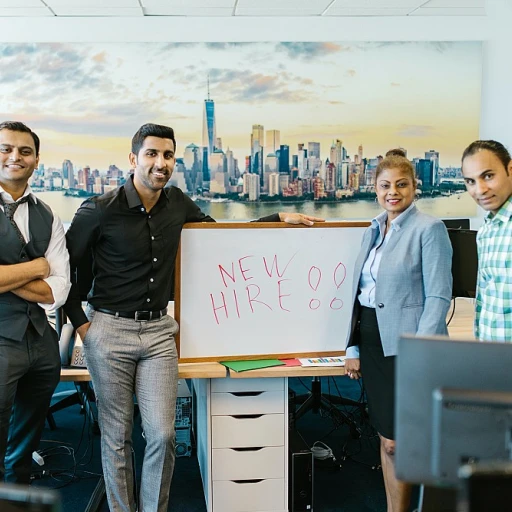
Understanding the Role of Mindset in HR Communication
Recognizing the Influence of Mindset in HR Interactions
Understanding the role of mindset in Human Resources communication is paramount for fostering personal and professional growth. The concept of a mindset underscores how our thoughts influence our actions and interactions within the workplace. A growth mindset, as opposed to a fixed mindset, encourages individuals to embrace challenges, learn from feedback, and continuously improve, all of which are crucial components in effective HR practices.
Mindset tools can be pivotal in reshaping how HR professionals communicate and manage their responsibilities. By integrating a learning mindset, HR teams can cultivate an environment where employees feel valued and motivated to reach their full potential. Tools designed to shift mindset can help in identifying and overcoming limiting beliefs, thus enhancing productivity and engagement.
For HR professionals, a focus on fostering positive thoughts and reducing negative talk can significantly impact employee relations. Encouraging mental strength among team members can influence how people respond to workplace challenges and change. Moreover, incorporating productivity tools focused on mindset can streamline HR processes, leading to more efficient communication and problem-solving.
By consistently applying these concepts, Human Resource departments can profoundly impact employee satisfaction and retention rates. The quick scorecard approach offers an effective means to evaluate these evolving interactions and measure improvements in communication strategies over time.
Identifying Key Mindset Tools for HR Professionals
Key Mindset Tools for HR Professionals
In the realm of human resources, adopting the right mindset tools can significantly enhance communication and overall effectiveness. These tools are not just about improving day-to-day interactions but also about fostering a culture of growth and learning within the organization. Here are some essential mindset tools that HR professionals can leverage:
- Growth Mindset: Encouraging a growth mindset among employees can transform how they perceive challenges and setbacks. This mindset emphasizes learning and personal growth, allowing individuals to view obstacles as opportunities for development rather than insurmountable barriers.
- Circle of Control: This tool helps individuals focus on what they can control and influence, rather than getting bogged down by things beyond their control. By concentrating on actionable areas, HR professionals can guide employees to be more productive and less stressed.
- Limiting Beliefs Identification: Identifying and challenging limiting beliefs is crucial for personal and professional growth. HR professionals can help employees recognize negative thoughts that hinder their progress and replace them with positive, empowering beliefs.
- Productivity Tools: Utilizing productivity tools can streamline HR processes and improve communication efficiency. These tools help manage time and tasks effectively, ensuring that HR professionals can focus on strategic initiatives.
- Mental Strength Coaching: Building mental strength is vital for handling workplace stress and maintaining a positive outlook. Coaching sessions can provide employees with strategies to enhance their resilience and adaptability.
Implementing these mindset tools requires a strategic approach and a commitment to continuous improvement. For more insights on how to integrate these tools into your HR practices, consider exploring understanding the 2-2-3 work schedule as a part of your strategy.
Implementing Mindset Tools in HR Practices
Embracing Mindset Tools in Human Resources Communication
Integrating mindset tools in HR practices requires a balanced approach, ensuring that the tools chosen align with the specific needs of the organization. By focusing on growth and learning, HR professionals can create a positive shift in their communication strategies, directly impacting their work environment.
First, it's essential to foster a growth mindset, encouraging both personal and professional development. A growth mindset helps individuals focus on their potential, rather than being restrained by their current abilities. This optimistic outlook can lead to improved problem-solving and innovation in the workplace.
HR teams should prioritize learning mindset engagement by incorporating resources and training aimed at developing mental strength and perseverance. Implementing productivity tools like time management exercises or collaboration software can further help employees become more efficient and proactive in their roles.
Overcoming the detrimental effects of a fixed mindset, where limiting beliefs can hinder performance, is another critical step. HR professionals can facilitate workshops on eliminating negative or unproductive thoughts, helping clients build resilience and adaptability in various areas of life and work.
Insightful tools will help by offering guidance on identifying and capitalizing on the circle of control and influence. This allows employees to focus energy on things they can directly affect, fostering a positive environment and reducing unnecessary stress.
Adopting mindset tools doesn't demand significant financial investment, as demonstrated by numerous affordable ways to boost employee engagement. The benefits of these strategies can be profound, leading to enhanced communication and a more cohesive working culture over time.
Overcoming Challenges in Adopting Mindset Tools
Confronting Obstacles When Adopting Mindset Strategies
When introducing mindset tools into HR communication, several challenges can arise. The transition demands a shift in not only tools but also perspectives. A fixed mindset can be one of the most significant barriers. It limits the acceptance of change, preventing both individuals and teams from embracing new methods for personal and professional growth.
Negative thoughts and limiting beliefs often cloud decision-making processes. To address this, HR professionals can employ coaching techniques to foster a growth mindset within teams. By encouraging positive thoughts and focusing on areas of life that can be controlled, we can shift mindset dynamics from negativity to productivity. Utilizing tools such as productivity apps or mental strength exercises can reinforce these concepts and help clients or employees adapt.
The challenge extends beyond individual mental shifts; there is also the need to embed these mindset tools into daily work routines effectively. Learning tools that emphasize the growth mindset and fostering an environment that supports continuous learning and adaptation are crucial. Over time, these efforts will help create a more resilient HR team.
Resources are also a concern. Implementing these changes requires time and commitment, both of which are frequently scarce in busy HR departments. By prioritizing and allocating time to learning and development, HR departments can constructively address these challenges, thus making significant strides in improving HR communication.
Measuring the Impact of Mindset Tools on HR Communication
Evaluating the Effectiveness of Mindset Tools in HR
Measuring the impact of mindset tools on HR communication is crucial for understanding their effectiveness and ensuring they contribute positively to the workplace. By focusing on key metrics and feedback, HR professionals can gauge how these tools help in transforming communication practices.
Key Metrics for Assessment
- Employee Engagement: One of the primary indicators of successful mindset tools is improved employee engagement. When employees feel more connected and motivated, it often reflects a shift in mindset, from fixed to growth, enhancing overall communication.
- Feedback and Surveys: Regular feedback and surveys can provide insights into how mindset tools are perceived and their impact on daily work life. This feedback helps identify areas where tools help and where adjustments might be needed.
- Productivity Levels: An increase in productivity can be a direct result of effective mindset tools. By fostering a learning mindset, employees may feel more empowered to take on challenges, leading to better performance.
- Reduction in Negative Talk: Monitoring the frequency of negative thoughts and conversations can indicate a positive shift in workplace culture, suggesting that mindset tools are helping to create a more supportive environment.
Qualitative Insights
Beyond quantitative metrics, qualitative insights are equally important. Observing changes in team dynamics, such as increased collaboration and openness to feedback, can signal the success of mindset tools. These tools often help clients and employees alike to shift their mindset, encouraging personal and professional growth.
Continuous Improvement
It's important to remember that the implementation of mindset tools is not a one-time effort. Continuous evaluation and adaptation are necessary to ensure these tools remain effective. By regularly assessing their impact, HR professionals can refine their strategies, ensuring that mindset tools continue to support positive communication and growth within the organization.












